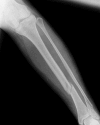Traumatic tibia and fibula fracture in a 36 weeks' pregnant patient: a case report
- PMID: 24358005
- PMCID: PMC3865835
Traumatic tibia and fibula fracture in a 36 weeks' pregnant patient: a case report
Abstract
Background: Bone fracture management in third-trimester pregnant patients is rare and poorly discussed in the literature. In the case of fractures that require orthopedic surgery in near-term pregnant women, clinicians should decide between operating before or after the delivery, carefully evaluating the health of the mother and fetus.
Case report: A pregnant 41-year-old woman at 36 weeks' gestation had a traumatic midshaft displaced tibia and fibula fracture. A multispecialty team approach resulted in nonoperative treatment until delivery. The sudden spontaneous premature rupture of membranes led to a preterm cesarean section. Five days after cesarean section, the patient underwent surgery for open reduction and internal fixation with pins and plates. The patient recovered well and was discharged with her baby.
Conclusion: The clinical and surgical management of bone fractures in pregnant women should be determined by a multispecialty team, and a tailored intervention should be chosen for each patient.
Keywords: Cesarean section; fibula; fractures—bone; pregnancy; tibia.
Conflict of interest statement
Figures
Similar articles
-
Guidelines for the Management of a Pregnant Trauma Patient.J Obstet Gynaecol Can. 2015 Jun;37(6):553-74. doi: 10.1016/s1701-2163(15)30232-2. J Obstet Gynaecol Can. 2015. PMID: 26334607 English, French.
-
[The Bosworth ankle fracture (case report)].Acta Chir Orthop Traumatol Cech. 2001;68(4):256-60. Acta Chir Orthop Traumatol Cech. 2001. PMID: 11706551 Czech.
-
Spontaneous isolated midtrimester fracture of tibia and fibula in a normal fetus with in utero healing and good long-term outcome.Fetal Diagn Ther. 2010;28(1):58-60. doi: 10.1159/000312406. Epub 2010 Apr 10. Fetal Diagn Ther. 2010. PMID: 20389052
-
Cesarean section on request at 39 weeks: impact on shoulder dystocia, fetal trauma, neonatal encephalopathy, and intrauterine fetal demise.Semin Perinatol. 2006 Oct;30(5):276-87. doi: 10.1053/j.semperi.2006.07.009. Semin Perinatol. 2006. PMID: 17011400 Review.
-
[Heart transplantations: impact on female fertility].Bull Acad Natl Med. 1991 Apr;175(4):531-40; discussion 540-5. Bull Acad Natl Med. 1991. PMID: 1933473 Review. French.
Cited by
-
A Surgical Opinion in a 36-Week Pregnant with Tibia Fracture: Intramedullary Nailing.Case Rep Orthop. 2016;2016:1454835. doi: 10.1155/2016/1454835. Epub 2016 Dec 13. Case Rep Orthop. 2016. PMID: 28070433 Free PMC article.
-
Displaced femoral neck fracture in a pregnant patient diagnosed with transient osteoporosis of the hip.SICOT J. 2022;8:44. doi: 10.1051/sicotj/2022045. Epub 2022 Nov 25. SICOT J. 2022. PMID: 36426960 Free PMC article.
-
Suprapatellar intramedullary nailing of tibial shaft fractures in pregnancy. A report of two cases.BMC Pregnancy Childbirth. 2022 Jun 28;22(1):528. doi: 10.1186/s12884-022-04835-4. BMC Pregnancy Childbirth. 2022. PMID: 35765043 Free PMC article.
-
Obstetric management of pregnant patients during an earthquake.Ulus Travma Acil Cerrahi Derg. 2025 Apr;31(4):358-364. doi: 10.14744/tjtes.2025.69209. Ulus Travma Acil Cerrahi Derg. 2025. PMID: 40211642 Free PMC article.
References
-
- Barraco RD, Chiu WC, Clancy TV, et al. EAST Practice Management Guidelines Work Group. Practice management guidelines for the diagnosis and management of injury in the pregnant patient: the EAST Practice Management Guidelines Work Group. J Trauma. 2010 Jul;69(1):211–214. - PubMed
-
- Fildes J, Reed L, Jones N, et al. Trauma: the leading cause of maternal death. J Trauma. 1992 May;32(5):643–645. - PubMed
-
- Ali J, Yeo A, Gana TJ, et al. Predictors of fetal mortality in pregnant trauma patients. J Trauma. 1997 May;42(5):782–785. - PubMed
-
- Rothenberger D, Quattlebaum FW, Perry JF, Jr, et al. Blunt maternal trauma: a review of 103 cases. J Trauma. 1978 Mar;18(3):173–179. - PubMed
Publication types
LinkOut - more resources
Full Text Sources

